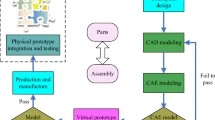Abstract
Aiming at the characteristics that electromyography (EMG) signals can reflect the human body’s motive intention and the information of muscle’s motive state, this paper makes a thorough study on the evaluation of surface electromyography signals’ motive state. At the same time, EMG signals can reflect the characteristics of limb movement and its changing rules, and can acquire the functional characteristics of limb movement so as to accurately evaluate the rehabilitation status of patients. In this paper, EMG signal analysis and feedback control are introduced into the virtual rehabilitation system to study the methods of EMG parameter identification and dynamic feature extraction, and obtain the EMG characteristics and variation rules related to human motion patterns. In this paper, a rehabilitation training system based on EMG feedback and virtual reality is built, and the validity of the system is verified by patient experiment. The feasibility of the system is verified by the methods of validity of the algorithm, recognition rate of the system action pattern and fatigue evaluation.









Similar content being viewed by others
References
Ju, Z., Ouyang, G., Wilamowska-Korsak, M. et al., Surface EMG based hand manipulation identification via nonlinear feature extraction and classification. IEEE Sensors Journal 13(9):3302–3311, 2013.
Jali, M. H., Ibrahim, I. M., Sulaima, M. F. et al., EMG signal features extraction of different arm movement for rehabilitation device. International Journal of Applied Engineering Research 9(21):11151–11162, 2014.
Bohari, Z. H., Jali, M. H., Baharom, M. F. et al., EMG signal statistical features extraction combination performance benchmark using unsupervised neural network for arm rehab device. International Journal of Applied Engineering Research 9(22):12393–12402, 2014.
Xu, X., Zhang, Y., Xu, X. et al., Surface EMG-based human-machine interface that can minimise the influence of muscle fatigue. International Journal of Modelling Identification & Control 22(4):298–306, 2014.
Farina, D., Jiang, N., Rehbaum, H. et al., The extraction of neural information from the surface EMG for the control of upper-limb prostheses: Emerging avenues and challenges. IEEE Transactions on Neural Systems & Rehabilitation Engineering 22(4):797–809, 2014.
Wu, S. A., Traffic motion object extraction algorithm. International Journal of Bifurcation and Chaos 25(14):1540039, 2015.
Hofmann, D., Jiang, N., Vujaklija, I. et al., Bayesian filtering of surface EMG for accurate simultaneous and proportional prosthetic control. IEEE Transactions on Neural Systems & Rehabilitation Engineering A Publication of the IEEE Engineering in Medicine & Biology Society 24(12):1333–1341, 2015.
Wei, P. S., Yoon, W. L., Escoffier, N. et al., Evaluating the training effects of two swallowing rehabilitation therapies using surface electromyography—Chin Tuck against resistance (CTAR) exercise and the shaker exercise. Dysphagia 31(2):195–205, 2016.
Wu, S., Wang, M., and Zou, Y., Research on internet information mining based on agent algorithm. Future Generation Computer Systems 86:598–602, 2018.
Xing, K., Yang, P., Huang, J. et al., A real-time EMG pattern recognition method for virtual myoelectric hand control. Neurocomputing 136(1):345–355, 2014.
Yu, W., Li, S., Tang, X. et al., An efficient top-k ranking method for service selection based on ε-ADMOPSO algorithm. Neural Computing and Applications:1–16, 2018.
Yu, W., and Li, S., Recommender systems based on multiple social networks correlation. Future Generation Computer Systems 87:312–327, 2018.
Malik, O. A., Arosha Senanayake, S. M. N., and Zaheer, D., An intelligent recovery Progress evaluation system for ACL reconstructed subjects using integrated 3-D kinematics and EMG features. Biomedical & Health Informatics IEEE Journal of 19(2):453–463, 2015.
Funding
This research is based upon work supported in part by the Characteristic Specialty Construction Project of Physical Education of Physical Education College of Zhengzhou University, and the National Natural Science Foundation of China(No. 61502350, U1536114).
Author information
Authors and Affiliations
Corresponding author
Ethics declarations
Ethical approval
This article does not contain any studies with human participants performed by any of the authors.
Additional information
Publisher’s Note
Springer Nature remains neutral with regard to jurisdictional claims in published maps and institutional affiliations.
This article is part of the Topical Collection on Image & Signal Processing
Rights and permissions
About this article
Cite this article
Meng, Q., Zhang, J. & Yang, X. Virtual Rehabilitation Training System Based on Surface EMG Feature Extraction and Analysis. J Med Syst 43, 48 (2019). https://doi.org/10.1007/s10916-019-1166-z
Received:
Accepted:
Published:
DOI: https://doi.org/10.1007/s10916-019-1166-z




